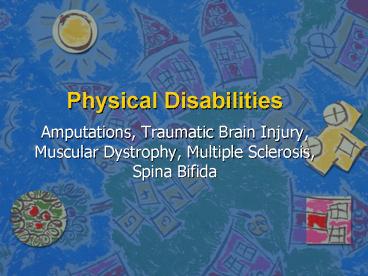Physical Disabilities - PowerPoint PPT Presentation
1 / 21
Title:
Physical Disabilities
Description:
Physical Disabilities. Amputations, Traumatic Brain Injury, ... Meningocele. Meningomyelocele. Sensory Disabilities. Hard of Hearing / Deaf. Low Vision / Blind ... – PowerPoint PPT presentation
Number of Views:781
Avg rating:3.0/5.0
Title: Physical Disabilities
1
Physical Disabilities
- Amputations, Traumatic Brain Injury, Muscular
Dystrophy, Multiple Sclerosis, Spina Bifida
2
Amputations
- Incidence
- Two major categories of limb deficiencies
- dysmelia
- phocomelia
- Limb Deficiencies
- Congenital
- Acquired (tumor, trauma, disease)
- Joint Intact vs. Joint Amputated
3
Limb Deficiencies and AmputationsConsiderations
- General Attitude -
- Prosthetics -
- Gaits and Movement Patterns -
- Balance -
- Energy -
- Concerns -
- cooling and perspiration
- skin breakdown
- posture
4
Adaptations
- Example of adaptation with someone with a
bilateral amputation
5
Other Physical Conditions
- Traumatic Brain Injury
- Muscular Dystrophy
- Multiple Sclerosis
- Spina Bifida
6
Traumatic Brain Injury
- Permanent Damage - caused by concussion,
contusion, or hemorrhage - Closed-head injuries - most common
- Leading cause of death and disability under 35
- Glasgow Coma Scale (GCS) -
- Based on 3 types of responses (a) eye opening,
(b) motor, and (c) verbal. - 3 to 15 points (8 - coma) (5-7 death/veg)
7
Muscular Dystrophy
- Degenerative muscular condition -
- 250,000 cases in U.S.
- Males 5-6x more prevalent than females
- Appx. 50,000 use WC
- Four main types
- Duchenne
- Facio-scapular-humeral
- Limb girdle
- Myotonic
8
Types of MD
- Duchenne Muscular Dystrophy
- Muscle fibers degenerate -
- Pseudohypertrophy -
- Frequent falls, contractures (Achilles tendon),
body imbalance - Gradual reduction in motor ability, wheelchair
use, and then ultimately death - Facio-Scapular-Humeral MD
- Limb Girdle MD
- Myotonic MD
9
Multiple Sclerosis
- Inflammatory disease of the CNS
- Demyelination bouts that last 1 to 3 months
- Degree of disability varies with each episode
10
Spina Bifida
- Failure of one or more vertebral arches to
properly develop and close
11
A True Story
12
Three types (levels of severity) of Spina Bifida
- Spina Bifida Occulta
- Meningocele
- Meningomyelocele
13
Sensory Disabilities
- Hard of Hearing / Deaf
- Low Vision / Blind
14
Deafness and Hard of Hearing
- P.L. 101-476 defines Hearing Impairment
- P.L. 101-476 defines Deafness
- Very few students are deaf most are hard of
hearing
15
Sound Characteristics
- Two primary characteristics of sound
- loudness / intensity
- frequency / pitch
- Loudness is measured by decibels (dB)
- Frequency is measured in hertz (Hz) or cycles per
second - Frequency is basically high and low pitch
- Communication
16
Classifications for Hearing Loss
- 5 classifications for hearing loss in (dB)
- Slight 25-40 dB loss
- Mild 41-55 dB loss
- Marked 56-69 dB loss
- Severe 70-90 dB loss
- Profound 91 dB or greater loss
- A 70 dB loss is the cut-off between hard of
hearing and deaf
17
Types of Hearing Loss
- Conductive -
- Conductive hearing loss - originates in outer or
middle ear - Sensorineural -
- Sensorineural hearing losses are more serious,
occurring in the inner ear
18
Low Vision and Blindness
- Definition, Causes, and Characteristics
19
Low Vision / Blind
- Legal Blindness Definition
- Less than 20/200 vision with best correction, or
- Less than 20 degree visual field with best
correction - Incidence - 1 in 3,000
- 25 total blindness
- 25 partial blindness
- 50 can read enlarged type
20
Structure of the Eye
- LIGHT CORNEA and LENS
- Retina
- Optic Nerve
- Brain
21
Blindness
- Causes
- anoxia
- intrauterine infections
- head trauma
- retinoblastoma
- nutrition disorders (vitamin A deficiency)
- Two types
- cortical - problem along visual pathway
- retinal - eye structure itself































